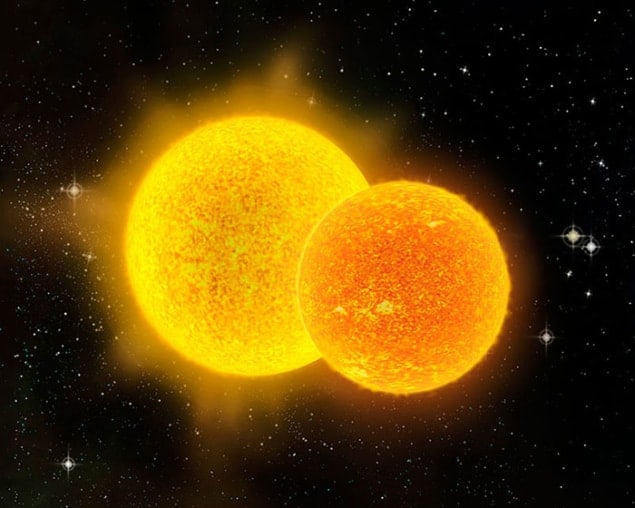
Physicists in Poland and the US have carried out computer simulations that shed light on the events leading up to the famous creation of gravitational-wave GW150914, which was detected last year by the LIGO observatory in the US. Their research paints a vivid picture of how two huge stars could have evolved over just a few million years into a pair of black holes that then merged, emitting a gravitational wave that eventually reached Earth. Such mergers, the team concludes from the simulations, are more common than thought, suggesting that the next generation of gravitational-wave detectors could rack up hundreds of similar observations every year.
Announced by members of the LIGO collaboration in March, the first-ever detection of a gravitational wave was made on 14 September 2015 by LIGO’s two giant interferometers. Astrophysicists reckon that GW150914 was created by a black hole about 36 times as massive as the Sun merging with a smaller black hole of about 29 solar masses. The resulting black hole is expected to be 62 solar masses, which makes these objects the three largest “stellar-mass” black holes known to astronomers (ignoring the much bigger supermassive black holes at the centre of many galaxies, including our own Milky Way).
Krzysztof Belczynski and Tomasz Bulik from the University of Warsaw have now joined forces with Daniel Holz of the University of Chicago and Richard O’Shaughnessy of the Rochester Institute of Technology to use a numerical model of stellar evolution to sketch out the events that led up to the creation of GW150914. Their simulations suggest that the story of GW150914 began about 12 billion years ago – just two billion years after the Big Bang – with the birth of two huge stars, each having about 40–100 solar masses.
Biggest and brightest ever
These stars, which formed from mostly hydrogen gas, were able to grow to huge sizes and would have been some of the most massive and brightest stars ever to exist in the universe. Stars like the Sun, in contrast, formed much later in the history of the universe, and could not get so big because they incorporated heavier elements created by previous generations of stars.
The simulations suggest that these stars orbited each other in a binary system for just four million years before one became a black hole without first exploding in a supernova. While the idea that a huge star could turn into a black hole without a supernova is controversial, it could help to explain why binary black holes as massive as those that created GW150914 came into existence.
No supernovae
The new black hole, the researchers believe, was then engulfed by the remaining star, such that the two objects shared the same envelope of gas. At this point, the astronomers surmise that the remaining star became a compact, hot core that then made the transition to a black hole – again without a supernova.
The team reckons that the conversion of the stars into black holes happened relatively fast – in just over five million years. This binary black-hole system then existed for a further 10 billion years, with the two objects slowly spiralling into each other before the merger occurred. This created GW150914, which then took 1.2 billion years to reach Earth.
While the regions of “pristine” hydrogen gas where the two massive stars formed are relatively uncommon in the universe, they should be highly visible to gravitational-wave detectors such as LIGO. “Because LIGO is so much more sensitive to these heavy black holes, these regions of pristine gas that make heavy black holes are extremely important,” explains O’Shaughnessy. “These rare regions act like factories for building identifiable pairs of black holes.”
Despite the rarity of the progenitors of GW150914, O’Shaughnessy and colleagues calculate that once the LIGO detectors are operating at their maximum sensitivity, they could be detecting as many as 1000 black-hole mergers per year in the 20–80 solar-mass range. Indeed, just last week, LIGO announced its second discovery of a gravitational wave, this time from a black-hole merger at about 21 solar masses.
The simulations are described in Nature.



